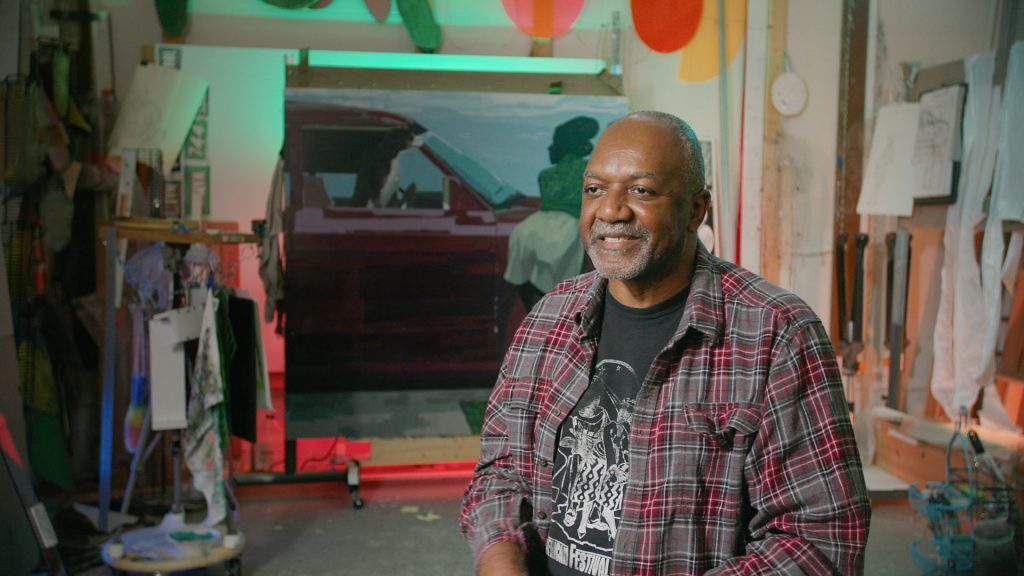Director Sam Pollard’s “Black Art: In The Absence of Light” Documentary
Kerry James Marshall, Faith Ringgold, Theaster Gates, Amy Sherald and others share their thoughts

In 1976, artist, art historian and curator David Driskell opened the doors to his landmark exhibition, Two Centuries of Black American Art, at the Los Angeles County Museum of Art (LACMA). The captivating, comprehensive study featured more than 200 works by 63 artists from the 19th and 20th century, but its expanse did not stop there; it toured the US and opened the eyes of thousand of visitors across the country. In Black Art: In The Absence of Light (premiering through HBO Max on 9 February), award-winning documentary filmmaker Sam Pollard celebrates Driskell’s work and traces its influence on Black artists working today.
Driskell died in 2020 from complications pertaining to COVID-19. In many ways, the documentary is a love letter to his work and the fact that he catalogued and honored the history of Black art in America, not only its current place at the time of the exhibition. In 1976, mainstream institutions weren’t allotting space for Black artists, let alone Black curators. Driskell broke through a wall and carried that momentum to the Dallas Museum of Fine Arts, the High Museum of Art in Atlanta and the Brooklyn Museum.

“The original concept proposed by myself and executive director Skip Gates was to build the film around Thelma Golden’s pioneering 1994 Black Male exhibit at the Whitney,” Pollard tells us. “However, Thelma [a consulting producer on this film] thought that was too narrow. She suggested we build the film around the groundbreaking 1976 exhibit Two Centuries of Black American Art, curated by the late David Driskell. From my perspective, that was a brilliant idea and really shows the importance of collaboration in the filmmaking process. Like most documentary filmmakers, the film’s shape and structure came from screening the interviews and really considering in the editing process how all the pieces would fit together.”

Pollard supports video clips of Driskell throughout the years with intimate interviews of celebrated Black artists in their studios. From Betye Saar to Faith Ringgold, Kerry James Marshall, Carrie Mae Weems, Kara Walker and Jordan Casteel, individual stories unfold that weave back into Driskell’s own.

The film presents numerous milestone works in contemporary art authored by Black artists. One such example, Amy Sherald’s portrait of First Lady Michelle Obama, allows the artist to speak about how the work changed her life. Not only did it propel her to international acclaim, the ensuing interest in her practice allowed her to pay off her student loans. Moreover, she was able to offer an image of representation that young Black girls could admire.

To address the extent of Black contributions in the art world, Pollard weaves in dialogues with academics, including Harvard art history professor Sarah Lewis and Duke University professor Richard J Powell. Insight from Spelman College’s Mary Schmidt Campbell, a woman who pioneered representation herself as the director of Harlem’s Studio Museum, outlines the opposition Black artists have long met from people funding the arts who often questioned her as to why Black artists needed a museum of their own.

Kasseem “Swizz Beatz” Dean, world-renowned music producer and founder of The Dean Collection, speaks to the joy of collecting and presenting Black artists. An avid collector, Dean also shows off his Hank Willis Thomas basketball (a collaboration with COOL HUNTING) in the film. His joy mirrors that of so many others in the documentary. It’s a powerful experience and one that continues the work Driskell set out to do. Hopefully, there will be more to come.

Black Art: In The Absence of Light—produced by Pollard and Daphne McWilliams, with a score by Kathryn Bostic—premieres on HBO at 9PM EST on 9 February. It will also be available on demand, on HBO Max, at that time. To accompany the film, HBO Max will present a virtual exhibition, also entitled Black Art: In The Absence of Light, honoring Driskell and inviting action and optimism over Black creativity and history. It will feature the artists from the documentary—including all of the aforementioned, as well as Kehinde Wiley, Radcliffe Bailey, Fred Wilson and many more. This activation will be free and accessible to all via blackartonhbo.com later this week.
Images courtesy of HBO












